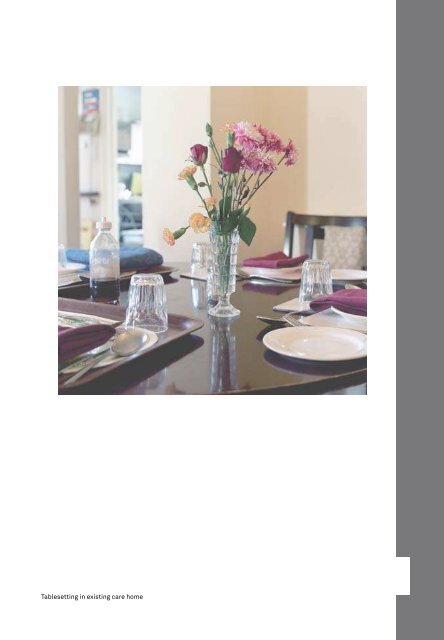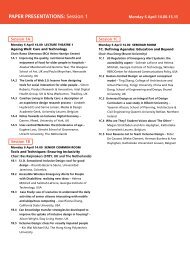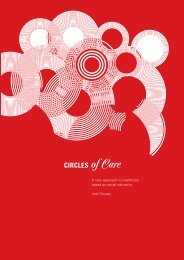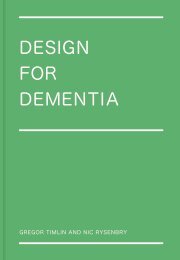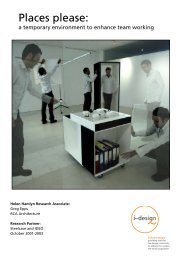Design for Dementia - Helen Hamlyn Centre - Royal College of Art
Design for Dementia - Helen Hamlyn Centre - Royal College of Art
Design for Dementia - Helen Hamlyn Centre - Royal College of Art
You also want an ePaper? Increase the reach of your titles
YUMPU automatically turns print PDFs into web optimized ePapers that Google loves.
DESIGN FOR FOR DEMENTIA<br />
DINING<br />
TABLEWARE<br />
The eating skills <strong>of</strong> residents in the mid to<br />
late stages <strong>of</strong> dementia can be improved and<br />
maintained through the use <strong>of</strong> appropriately<br />
designed tableware. This section highlights<br />
key features needed to improve the experience<br />
<strong>of</strong> meal times. An entire range <strong>of</strong> tableware is<br />
proposed here, designed to meet the varying<br />
abilities <strong>of</strong> people who find it challenging<br />
to eat due to dementia or reduced physical<br />
ability. Key areas <strong>of</strong> focus include reduction<br />
in visual acuity and dexterity.<br />
To examine which features appealed to<br />
residents and best supported their needs, an<br />
audit <strong>of</strong> existing products was used as a tool<br />
to discuss current solutions on the market.<br />
Care staff and residents all agreed assistive<br />
tableware was <strong>of</strong>ten childish in appearance<br />
and not age appropriate. Materials such as<br />
plastics were less desirable because <strong>of</strong> their<br />
cheap tactile quality and intrinsic colour<br />
schemes and that were either bright and<br />
childish, or beige, associated with assistive<br />
technology there<strong>for</strong>e becoming stigmatising.<br />
Products also appeared to be illconsidered<br />
<strong>for</strong> the care home setting and<br />
included basic failings that made them less<br />
functional and appealing. Problems included<br />
an inability to stack, materials that aged badly<br />
and the use <strong>of</strong> colours, particularly in plates,<br />
that made the food look unappealing.<br />
From research conducted in a variety<br />
<strong>of</strong> care homes it became clear that assistive<br />
tableware was <strong>of</strong>ten not stocked despite the<br />
fact that residents could have benefitted<br />
from them. Some managers opted not to<br />
include them in their kitchens because <strong>of</strong> the<br />
lack <strong>of</strong> aesthetic appeal. It was felt that they<br />
detracted from the quality <strong>of</strong> the meal.<br />
Current assistive tableware stood out<br />
from other pieces at the table and added a<br />
sense <strong>of</strong> stigma to the people using them. Care<br />
facilities have residents <strong>of</strong> diverse abilities<br />
and those residents who had to use assistive<br />
table settings felt different from the residents<br />
who could use standard tableware.<br />
1<br />
2<br />
3<br />
4<br />
The design <strong>of</strong> this new range <strong>of</strong> tableware sets<br />
out to achieve a number <strong>of</strong> goals.<br />
It aims to:<br />
Highlight specific features that could benefit<br />
older people in care.<br />
Provide commercially viable solutions that<br />
were durable and that could be permanently<br />
stocked in care homes.<br />
Create a range that matched as a set and<br />
<strong>for</strong>med a complete table setting so that<br />
people were not singled out by the objects<br />
they had to use.<br />
Ensure that solutions maintained a resemblance<br />
to domestic tableware so that plates<br />
looked like plates and cups which looked like<br />
cups. This was essential to ensure that the<br />
function <strong>of</strong> the objects remained clear and<br />
obvious <strong>for</strong> people at the more advanced<br />
stages <strong>of</strong> dementia.<br />
Tablesetting in existing care home<br />
51


